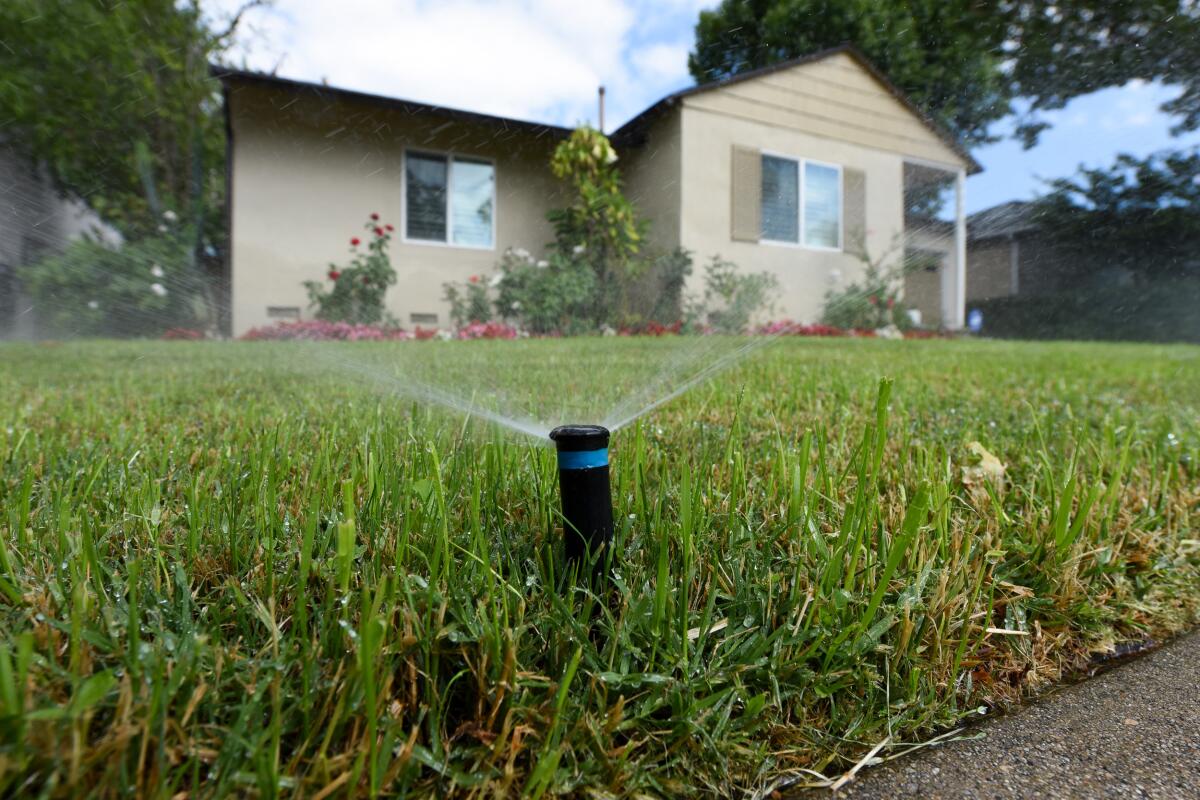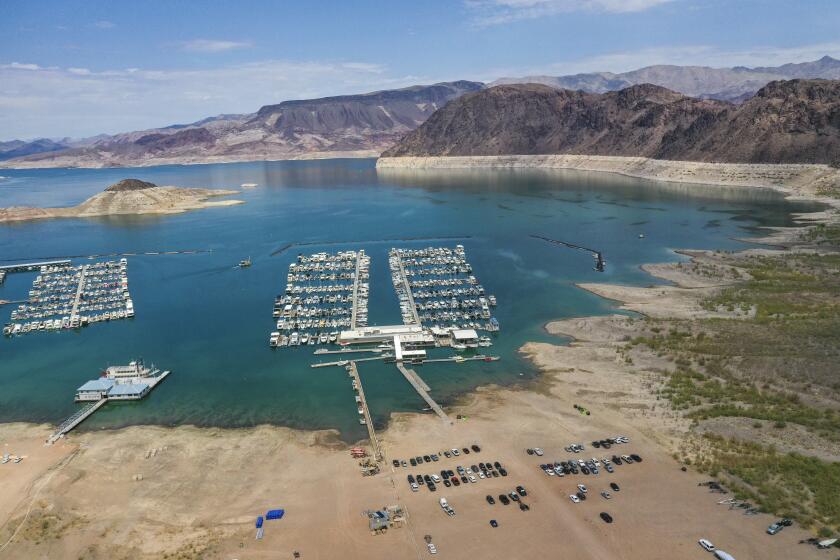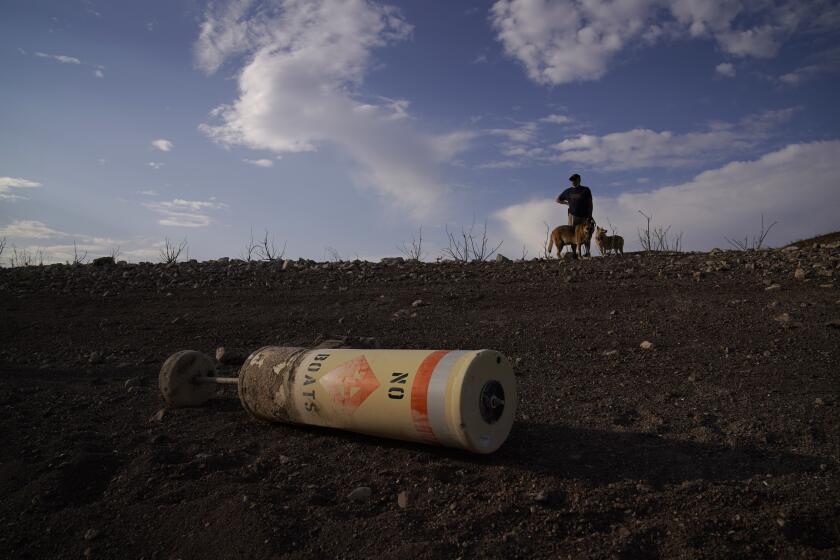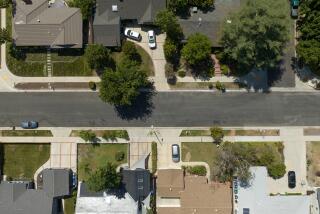Despite Newsom’s call to cut water use, L.A. and San Diego didn’t conserve in July

- Share via
Despite an appeal by Gov. Gavin Newsom for all Californians to voluntarily cut water use by 15%, Southern California has lagged in conservation efforts and even increased water consumption slightly in Los Angeles and San Diego, according to newly released data.
More than two months after Newsom stood by a depleted reservoir in San Luis Obispo County to make his plea, figures released Tuesday by the State Water Resources Control Board show that conservation efforts have varied widely from north to south.
On average, Californians reduced water use by just 1.8% statewide during July, compared with the same month last year. In Southern California, however, water use hardly changed among the region’s 19.7 million residents.
According to the new data, water use across much of Southern California dropped by just 0.1% overall, and rose by 0.7% in Los Angeles and 1.3% in San Diego.
Those figures contrasted sharply with regions to the north, where the effects of drought have been felt more heavily. Water suppliers in the North Coast region reported a 16.7% decrease in water usage, while Bay Area water use dropped 8.4%.
Areas that met the governor’s conservation target included Mendocino and Sonoma counties — regions that Department of Water Resources Director Karla Nemeth described as being in the “bullseye for the drought early on.”
Southern California water district calls for local agencies and consumers to voluntarily reduce water consumption to avoid more severe restrictions.
“We’re going to need all Californians to conserve, and conserve a lot more,” Nemeth said.
Newsom called for a voluntary 15% reduction in water use on July 8.
State water officials have been tracking monthly data for more than 400 water suppliers statewide, including most of California’s cities, towns and water districts. The statistics for July included data reported by 378 of these water suppliers.
The state water board will be presenting the data each month as the drought persists — much the way it did during the last major drought from 2012-16, when the state imposed mandatory conservation measures.
Water officials say they’re putting a stronger focus on the need for saving water as California deals with a year of unprecedented heat and extremely dry conditions that have sent some reservoir levels falling to record lows. Nemeth said all regions of the state need to do more to save water, including Southern California.
“We do want to see L.A. into that 15% voluntary” level of water-savings, Nemeth said. “We do think it’s feasible.”
Monthly water use is typically highest in the hot summer months, when plants in yards take up more water and evaporation increases. This July was significantly hotter than last July in Los Angeles, which the city’s Department of Water and Power cited as one factor that pushed water use higher. The department has activated a water shortage contingency plan and says it has stepped up a conservation program to encourage customers to cut back.
E. Joaquin Esquivel, chair of the state water board, said he looks forward to seeing what the numbers will show in August.
U.S. officials declared the first-ever water shortage for the Colorado River that serves 40 million people in the West.
“Looking at the last drought, it takes time for conservation to boot up,” Esquivel said. “We’re going to have to continue to dig in deeper.”
Laurel Firestone, a member of the water board, said it’s simply time for everyone to do their part.
“And that means now,” Firestone said. “Treating this like the crisis that it is requires us all to step up far and above what we’re seeing in this first month’s report.”
Some of the hard-hit water suppliers in the North Coast region have adopted mandatory water restrictions and other measures to reduce their water footprint.
“They didn’t get the precipitation up there, and they moved pretty quickly,” Nemeth said of the northern counties. “And we’re pleased about that, and we’re pleased that it’s been locally led.”
Californians dramatically reduced water use during the 2012-16 drought, when then-Gov. Jerry Brown imposed a mandatory 25% cut in urban water usage. Many conservation habits have remained since then. Statewide, per capita water use decreased 16% between 2013 and 2020, according to state water officials.
“In the last drought, we saw an incredible response from Californians,” Esquivel said. “That’s going to be the continued spirit that we’re going to need in the months ahead.”
The extreme drought has left California’s large reservoirs, from Lake Oroville to Folsom Lake, at some of their lowest levels ever.
The snowpack in the northern Sierra Nevada, which feeds the state’s reservoirs, peaked at 72% of average in April, and then rapidly melted during the hottest spring on record. Extreme heat has baked much of the West and left parched soils, which have soaked up a portion of the runoff and left far-below average flows in the state’s rivers.
“What transpired this year was truly that climate change is here and our models regrettably don’t best capture the scenarios and circumstances we’re in,” Esquivel said. He said the difficult water situation has required changes in how state officials plan water supplies.
This year, cities and water districts have obtained just 5% of their full water allotments from the State Water Project, which delivers water with pumps and canals from the Sacramento-San Joaquin Delta to Southern California. Next year, managers of water districts anticipate that those allocations could be reduced to zero.
The Metropolitan Water District of Southern California, which delivers water to cities and smaller districts, declared a water supply alert in August and urged people to conserve.
The MWD stores water in reservoirs supplied by the State Water Project, and it also relies on water from the Colorado River. Federal water managers have declared a first-ever water shortage on the Colorado River, and if water levels continue declining as projected, those shortages could begin to shrink the amount of water flowing to Southern California within the next few years.
For now, Colorado River water accounts for more than half of Metropolitan’s total water supplies, and the district is storing water from the State Water Project in reservoirs that remain at higher levels than the severely depleted reservoirs in Northern California.
“We do want to give water districts an opportunity to work with their customers to do it voluntarily,” Nemeth said. “We want those local boards to be in a position, if they need to go to mandatory [water restrictions], to do that at the local level.”
She noted that the state has begun to relaunch a drought campaign called Save Our Water, offering information about how people can conserve, including steps like replacing thirsty lawns with drought-tolerant plants. The MWD and other water suppliers also offer rebates to help homeowners with the costs of taking out grass and putting in plants that consume less water.
The state water board tracks monthly water use in cities and towns, while handling agricultural water deliveries differently. This summer, the board issued an emergency order barring thousands of water rights holders, including farmers and other landowners, from diverting water from the delta.
Esquivel said the 15% statewide target is intended “to help all Californians really connect to the work.”
“What it has the power of doing, and we saw has done before, is really bring Californians together and help them understand,” he said, “how to improve and contribute to the long-term resiliency of our systems.”
Esquivel said everyone needs to continue focusing on using less water because the science shows that as the world continues to heat up with the burning of fossil fuels, droughts are growing more intense in the West.
“Climate change isn’t going anywhere. Droughts are certainly not going anywhere,” Esquivel said. “And we know they will grow deeper.”
Scientists who are part of a federal drought task force said in a new report released Tuesday that the historic drought in the Southwest during 2020 and 2021 is the most severe and widespread on record, and has been “made more impactful by human-caused warming.” Precipitation since January 2020 has been the lowest on record since at least 1895, while temperatures have reached the third-highest 20-month average on record.
“This exceptional drought punctuates a two-decade period of persistently warm and dry conditions throughout the region,” the scientists wrote in the report, which was released by the National Oceanic and Atmospheric Administration. “The warm temperatures that helped to make this drought so intense and widespread will continue (and increase) until stringent climate mitigation is pursued and regional warming trends are reversed.”
The authors wrote that rising temperatures due to emissions of greenhouse gases “will make even randomly occurring seasons of average- to below-average precipitation a potential drought trigger, and intensify droughts.” They said these “human-caused increases in drought risk will continue to impose enormous costs” for approximately 60 million people in six states, and that will require major efforts to adapt to a more arid Southwest.
Justin Mankin, the lead author and an assistant professor of geography at Dartmouth College, said the task force’s findings underline the importance of preparing for more frequent and more intense droughts like this one.
“It also highlights the costly risks of continuing to emit greenhouse gases at current levels,” Mankin said.
More to Read
Sign up for Essential California
The most important California stories and recommendations in your inbox every morning.
You may occasionally receive promotional content from the Los Angeles Times.













